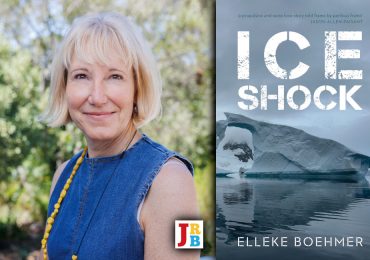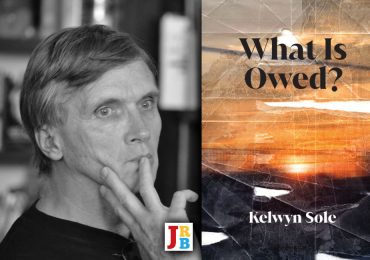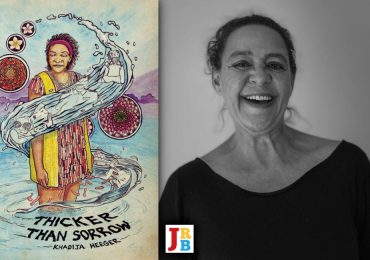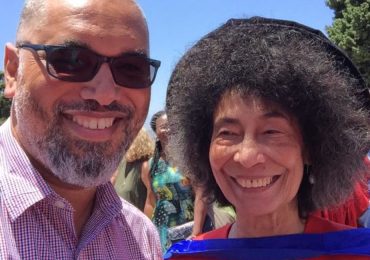Toni Giselle Stuart reviews Gabeba Baderoon’s poetry collection The History of Intimacy, which won the 2019 University of Johannesburg Main Prize and a 2020 Humanities and Social Sciences Award.
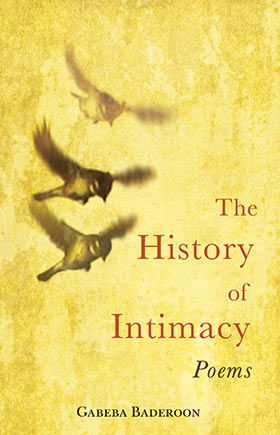
The History of Intimacy
Gabeba Baderoon
Kwela Books, 2018
The History of Intimacy, Gabeba Baderoon’s first collection of poetry in more than ten years, offers the same subtle gaze on everyday life as her earlier work, but in it she turns her lens and pen more directly to our political histories and cultural identity-making in the aftermath of apartheid.
The collection could just as aptly have been titled The Intimacy of History. The poems expose and ask us to confront all the ways in which colonialism and apartheid were personal. Baderoon takes us into overlooked moments of the everyday, where, perceptible or not, Verwoerd’s ideology most certainly reached. Those moments where the effects of democracy might not yet have been felt, because they reside in our minds and hearts, and no changing of laws can determine how fast or slow we heal.
Baderoon also writes about the intimacy of physical spaces: from the room of her childhood, to the room she shares with her partner; from standing in line to have identity photographs taken, to the silent intimacies of cities. She writes about the intimacy of words and language, exploring how these are used in the creation of ideas of place, and self.
Finally, she maps the distance between now and then, between the present and the past, as an intimate moment of remembering, of listening for what still speaks to us across time. Threaded through this breadth of physical space and time is a more subtle exploration, which I would like to focus on and draw out for the purposes of this review: that is, the way Baderoon ‘writes Athlone’, as I see it.
Athlone: a brief history
Greater Athlone is a large geographical area in Cape Town that was designated for Coloured South Africans under the apartheid Group Areas Act. It consists of townships with council flats, as well as suburbs with freestanding houses. A large part of the area existed long before apartheid, while other areas such as Hanover Park, Bonteheuwel and Manenberg were created during apartheid, to rehouse people whom the apartheid government uprooted from their homes in areas that the government declared white.
As a result, Athlone is physically vast and diverse: from working class to middle class to relatively wealthy, including families who speak English and Afrikaans, churches and mosques in the same street, and Christians and Muslims as neighbours, often in the same extended families. Athlone is home to the Joseph Stone Auditorium, where the cultural association the Eoan Group, famous for its opera productions, was based. It is also home to Athlone Stadium, the largest soccer stadium on the Cape Flats. The area has raised numerous sporting heroes, artists, teachers and educators, thinkers and political activists. The late Dulcie September and Imam Abdullah Haron were from Athlone, and Ashley Kriel from nearby Bonteheuwel. Dullah Omar lived in Athlone later in life, and was buried from there. In addition to Baderoon, the area has also cultivated the poets James Matthews, Mavis Smallberg and Andre Marais, among others.
But if the area’s history is rich and complex, it is yet largely unwritten. For example: Silvertown, one of the older suburbs, was created to give homes to members of the Cape Corps—the military unit in which Coloured troops served—demobbed after World War II. Many of the families who live there can trace a grandfather or great-grandfather who served in the Cape Corps. And Athlone is not without its problems and controversies, including class discrepancies and the colourism of racialised people, alongside the poverty, unemployment, gender-based violence and gangsterism that prevail, to varying degrees, across the communities that make up the area.
An excavation of small hurts
It is against this backdrop that Baderoon writes, taking us into her childhood home on the streets of a suburb in Athlone.
In ‘No Name’ she writes: ‘Don’t tell me that the small hurts don’t matter, that our private/ emptiness doesn’t count.’ As someone who grew up in Athlone myself, I appreciate the subtlety with which Baderoon writes about her time growing up here. While she is a generation older than I, her work suggests and alludes to a more nuanced experience than is generally recounted, and recalls some of the less-discussed aspects of being raised in a community classified as Coloured. That is to say, it gestures toward the ‘small hurts’—the invisible wounds of this classification and its impact on how families and communities saw, and see, themselves, during apartheid and after.
It is the intimacy of these small hurts to which Baderoon gives us access. We witness the impact of her family’s forced removal from Claremont to Athlone; her experience of being raised here; and her wrestling with identity as she moves into the world as a young adult and beyond.
Athlone of the skin
Our first introduction to the poet’s relationship with the area is through the skin. In her poem ‘Surface’, she writes:
we sat around talking after a conference
in the mountains and a white boy asked us
to make names for the colours of our skin,
a conversation we could only have
far from where we lived
in separate parts of the city … //Athlone coffee, I offered, not admitting
Ricoffy, the cheap instant we used in our house,
one spoon of sugar tapped level
against the rim of the bowl, condense
milk not quite mixed in, eddies
inside the dark making
the colour of my hand as I stirred.
Here Baderoon uses two images alongside each other: the colour of her hand and the daily ritual of making a cup of coffee. In the instant of reading the poet’s response to the question posed—‘Athlone coffee’—an image rises in one’s mind. For those who may not know, Ricoffy tends to be a wan or weak brown in colour. And while the reality of skin spectrums in Coloured communities means that it definitely does not speak for everyone, the comparison offers a particular kind of familiarity that is immediately resonant.
In addition to the two images, the mention of ‘condense milk’ is a further nod to the homes we grew up in. It immediately conjures memories of the short tin being prised open, the sickly sweet syrup being spooned into tea and coffee cups. This use of colloquial language without italics or footnote is a subtle yet important political choice: not to other the ways in which English is spoken in Coloured communities; to acknowledge language as an extension of identity-making.
Returning to the poem ‘No Name’, this grappling with skin and what it means is raised again:
Our salt was No Name. Our milk. Our clothes. Ourselves.
Through these plain white boxes with blue writing, the label of
No Money fell on us, stuck to our skin, told us that we ourselves
were generic, interchangeable. No Name was clear on our bodies.
To not matter at the level of skin was the law, but to not matter
at the level of what we wore and ate—that cut deeper than law.
This ‘not mattering’—an invisible small hurt, borne by those of us classified Coloured. It is the unconscious hum that fills our lives. It is rarely directly said, but rather learned through the behaviour and actions of the adults and elders around us.
Further on in the poem, Baderoon writes about how the political move to refute the term ‘Non-white’ and identify as Black was an attempt to reclaim power and see oneself in whole terms, not in negation. But with the arrival of apartheid, she writes, ‘we thought our public fullness was enough,/ we thought we were ready for the pell-mell factories of desire/ and debt’ and so gave up homemade food and clothes for all things shop bought, as a way to assert our power and being-ness. However, yet again the stories of skin win out:
But what we knew consciously was nothing to what
we knew in our skin.
And:
In freedom we wear brands
on our skin until we believe what they say, until no one can tell
by our clothes who exists and who does not.
At the beginning of the collection, the question of skin is alluded to in the poem ‘Tell Me What You See’, which describes the experience of going to have identity photos taken for a driver’s licence. The moment of different lives rubbing against each other in the small photo cubicle—both in the way clients engage with the photographer, and in the way unclaimed photos of past clients fill the wall—is a microcosm of South Africa as a whole:
Hundreds of unclaimed photos line the inside
of his caravan the making of identity
interrupted and turned into small sad signs
of something else
We don’t look at each other so we look
at the walls at the faces no one came to collect […]
This ‘making of identity interrupted’ is a foreshadowing of what the poet shares later, around her own relationship to, and experience of, skin: her grappling with the classification of Coloured and the label of Non-white. Baderoon shows us how the act of having identity photos taken is in fact an intimate one, and yet always done in public, with others watching. In the same way, the act of identity-making for Coloured South Africans is interrupted by the very classification itself, and then furthermore by the need to prove oneself in the public gaze.
Athlone as a home built out of loss
The second way in which Baderoon ‘writes Athlone’ is through recounting her relationship to the place itself, which reads, at times, as ambivalent and troubled. The apartheid government forcibly removed her family from Claremont to Athlone: the area is one of hurt and trauma, a constant reminder of what was taken from them.
In her poem ‘The Flats’, we read:
I was born on the Flats
with its sand streets and damp walls,
a winter child, a child of loss.
and further on:
Born in the new place, I was their ghost child,
a grief growing
older and older.
That her parents had to pass their old house on their way to work each day further entrenched their hurt and loss. While not all families were forcibly moved here, Athlone is a community marked by an unexpressed grief—a grief our parents, grandparents and elders buried in their religions and their determination to give their children what they never had. Humour, the importance of family, and the unabashed celebration of important occasions provided strength, relief and release.
There is a silence that covers and protects this loss and grief, borne of the invisible violence of our colonial and apartheid past that persists to this day, and which we are only now beginning to find the language for, to express all of the ‘small hurts’.
It is into this silence that Baderoon writes, with a care and a gentleness that does not re-traumatise but rather bathes the wound so it might begin to dry out and heal. She achieves this with simple sketches that speak directly to the experiences of our childhoods and family homes, such as this, from the poem ‘Ghost Technologies’, about the arrival of television, and later computers:
Each night, we children eat hurriedly in the next room,
our eyes already sidling through the door to the blank screen.
Returning to the poem ‘The Flats’, Baderoon maps the distance between the home the apartheid government stole from her family in Claremont, and the home they were moved to in Athlone, both physically and emotionally. Her line ‘and they were removed/ to a place you cannot trace from here’, speaks of a tracing and mapping that is physical, while ‘They turned distance into an ordinary tragedy/ and eventually a home’, maps the emotional distance her parents had to travel, and the emotional labour they had to undertake, in order to make a home and raise a family in the new place.
This intimacy of loss is further extended, as Baderoon writes about forgiving her parents for ‘their slow love/ of the new place, of me’. For her, Athlone is both a physical and an emotional location. And while the loss is clear, the poet also seems to find love and a sense of place. Towards the end of the collection, in the title poem, Baderoon writes about her mother’s desire to return to Claremont when the Group Areas Act is abolished, but her children refuse:
and it is we, grown attached
to the scar we call home, who say, No,
we don’t want to live in a white area,
this time ceding it ourselves.
To make a home out of scars. To shield oneself from being too close to whiteness. Both are protective measures (whether conscious or not) for survival, by a community wounded and traumatised. Here, we see too the intergenerational differences between what Baderoon’s mother experienced and lived with, and the way her children chose to respond to apartheid’s brutality, to hold on to some sense of self.
It speaks, too, to the unconscious and invisible Group Areas Act of the mind—and where we may or may not allow ourselves to move and exist in the cities we live in, based on race classification and who occupies those spaces. This is particularly resonant in a city like Cape Town, where privilege and economic freedom are still largely in white hands.
Mapping pain with care
Baderoon writes Athlone into and through her work via memory and image-making. The place appears directly in just a handful of the poems, but it suffuses the collection, even as the poet writes about racism in the United States, where she now lives, or the port and river cities she has walked in Europe. It is an almost invisible language, and one that may not be seen by those not raised here or in areas with similar histories and cultural make-ups. But it is there, and its being there, I believe, makes for an important moment in South African poetry. Important because Baderoon uses the very spatial geography that sought to render us ‘Non’ to map our un-negated loss and grief; and, writing about Athlone intimately, she thus takes it into her care.
In both of her previous twot collections (The Dream in the Next Body, published in 2005, and A Hundred Silences, published in 2006), Baderoon draws us deep into her familial relationships, her childhood and adult homes, and to the quiet spaces between herself and those with whom she is closest. The use of silence, quiet and understatement are key aspects of her poetry. Reading through her work, one almost imagines the poet writing with a pencil, pressing as lightly as possible. She employs quiet, along with a clean simplicity in her use of voice and language, to draw us into intimate spaces, and to ask us to reflect on the questions and challenges she poses. To watch Baderoon read her work is to understand this quietness in a visceral way. It is not the quietness of not speaking. Rather it is the quietness of one who knows that some truths must be spoken softly to be heard.
In his book Anam Cara, the poet John O’Donohue wrote:
The secret and the sacred are sisters. When the secret is not respected, the sacred vanishes. Consequently reflection must not shine too severe or aggressive a light on the world of the soul.
This is the power of Baderoon’s poetry: it uses a gentle eye to consider all that is intimate between us, and in doing so, renders these quiet and still moments as sacred. In The History of Intimacy, she has rendered our most painful histories through an unobtrusive lens. She has written them with care, and left space and silence around them, so they (and we) may have room to breathe. In the act of listening, we render them sacred, and might begin to heal.
- Toni Stuart is a poet, performer and spoken word educator. Her work has been published in anthologies, journals and non-fiction books locally and abroad. In 2013 she was named on the Mail and Guardian’s list of 200 inspiring Young South Africans. She has an MA from Goldsmiths, University of London, where she was a Chevening Scholar. She was the founding curator of Open Book Festival’s Poetica programme. Follow her on Twitter.

